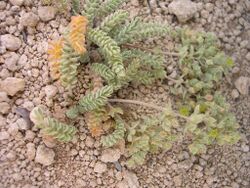Biology:Ivesia rhypara
| Ivesia rhypara | |
|---|---|

| |
| Scientific classification | |
| Kingdom: | Plantae |
| Clade: | Tracheophytes |
| Clade: | Angiosperms |
| Clade: | Eudicots |
| Clade: | Rosids |
| Order: | Rosales |
| Family: | Rosaceae |
| Genus: | Ivesia |
| Species: | I. rhypara
|
| Binomial name | |
| Ivesia rhypara Ertter & Reveal
| |
Ivesia rhypara is a species of flowering plant in the rose family known by the common name grimy mousetail, or grimy ivesia. It is native to Oregon and Nevada in the United States.[1]
This perennial herb grows from woody roots and a branching caudex.[2] It has hairy, overlapping, compound basal leaves and stems up to 15 centimeters long. At the ends of the stems are clustered white or pale-yellow flowers. Blooming occurs in May through October.[1][3]
There are two varieties of this plant. The var. rhypara grows on barren tuff and var. shellyi grows in rock cracks and crevices on pumice and tuff.[1] When the plants grow in rock fissures they sometimes appear to be lined up in rows.[4] Associated plants include Purshia tridentata, Poa sandbergii,[1] Gilia congesta, Sitanion hystrix, Scutellaria nana, and Eriophyllum lanatum.[3]
Threats to this species, particularly var. rhypara, include gold mining, as the habitat contains gold deposits. Other threats include cattle, off-road vehicles, fire suppression, and loss of pollinating insects.[4]
The plant gets the name rhypara ("grimy" in Greek) both from its dusty appearance and from its discoverer, James W. Grimes.[3][4]
References
- ↑ 1.0 1.1 1.2 1.3 Ivesia rhypara. The Nature Conservancy.
- ↑ Ivesia rhypara. Nevada Natural Heritage Program.
- ↑ 3.0 3.1 3.2 Ivesia rhypara. Oregon Department of Agriculture.
- ↑ 4.0 4.1 4.2 Ivesia rhypara var. rhypara. Center for Plant Conservation.
Wikidata ☰ Q6098823 entry
 |


